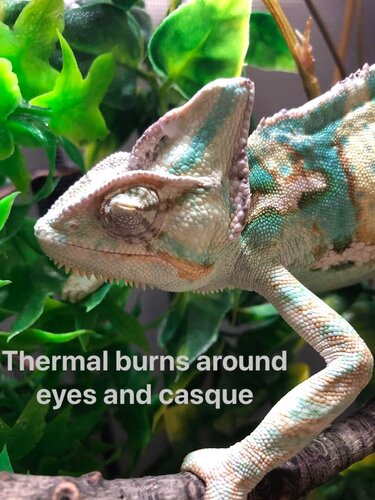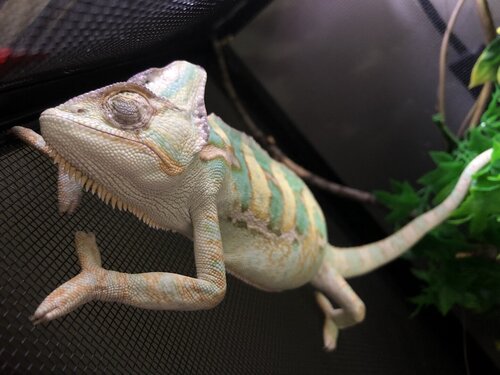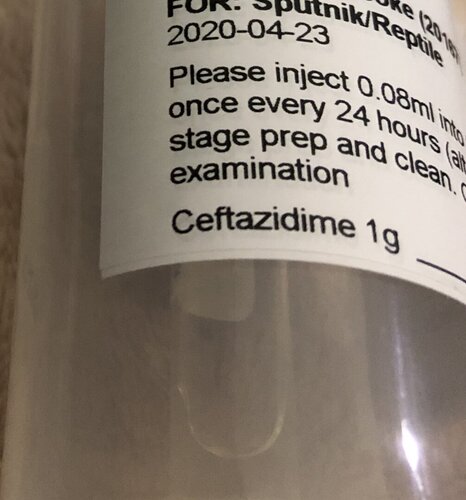KittyB
Member
Hey folks.
So brief run down, Male Veiled named Sputnik who has lived with me since Dec 13 and he was estimated to be about 5 months old at the time.
Housing is the standard chameleon starter kit with the addition of a Ficus repotted in organic soil and leaves washed in soap and water. (watched the vid tutorials)
This chameleon went off crickets some time ago and was only accepting meal worms and had a penchant for bananas and the odd fruit. The staple of his diet was dusted worms. He has a thing for Strawberries and got those as treats once a week.
He grew a lot and always seems to be in a state of shed somewhere. And always always wanted food.. He knew the container that housed his worms and would climb down and sit on the ground near them (he could see them until I decided to move them because that's literally all he cared about lol)
The basking bulb that came with his kit burned out 4 weeks after I got him and the employee at petsmart I usually deal with gave me a 75 watt "intense basking spot" Exo Terra bulb free of charge in replacement telling me that this would be much better for my cham.
Being a novice (albeit a very grown adult responsible pet owner) I didn't question this.. over time I noticed my chameleons back was turning blackish..
Long story short, it got bad.. eyes closed, wasn't eating or drinking had to do showers for hydration..
I live in Toronto and we have 3 reptile vets in this city, I took him into one of the better ones and had a full blood work panel done, Vitamin B12 injections and Vitamin A injections and sub Q injections, he looked like a new little dude when we left the vets as he had been refusing food for about a week prior to the visit, being a cancer survivor and having had radiation burns as a result I still had Fucidin on hand and had already been using it on the black area on his spine (the vet agreed she would have prescribed similar and to continue this and commended me) his eyes however really concern me.. he kept rubbing his head on his enclosure and you could tell he was uncomfortable and they legit looked scarred and damaged.
Fast forward.. he's getting an eye wash 2x daily, hydrating eye gel 2x daily.. he's currently being syringe fed Emerald (he loves loves loves that) and drinking water from a syringe. He's also on Tramadol for his pain.
His bloodwork came back great! all of his organs are ok and so are his calcium levels but he has inflammation markers and elevated white blood cells.. he is now on Antibiotics every day that I inject into him, I suspected he may have had an upper respiratory by the way kept holding his head up at an angle and not sleeping in his usual spots, but we also wondered if it was a systemic infection from the burns. Today is day 3 of antibiotics and he was much more active and climbing around his cage and sleeping in his plants. However he will only barely peek open his eyes.. and prefers one over the other.
Money is not an issue here.. ha ha I'm already 700.00 deep in his vet care alone.
My question is this.
I now have a blue 100watt "basking bulb" but he seems to hide from it. I also have a ceramic heating element and a 13 watt fluorescent bulb.
What should I be doing for his lighting given the condition of his skin?
I'm generally following my vets advice at this point and yes I will be going after pet smart as I have it in writing that it was the wrong bulb.
He weighed 83 grams at his vet visit and He's 6 inches long not including his tail. He's more than tripled his size since I got him.
So brief run down, Male Veiled named Sputnik who has lived with me since Dec 13 and he was estimated to be about 5 months old at the time.
Housing is the standard chameleon starter kit with the addition of a Ficus repotted in organic soil and leaves washed in soap and water. (watched the vid tutorials)
This chameleon went off crickets some time ago and was only accepting meal worms and had a penchant for bananas and the odd fruit. The staple of his diet was dusted worms. He has a thing for Strawberries and got those as treats once a week.
He grew a lot and always seems to be in a state of shed somewhere. And always always wanted food.. He knew the container that housed his worms and would climb down and sit on the ground near them (he could see them until I decided to move them because that's literally all he cared about lol)
The basking bulb that came with his kit burned out 4 weeks after I got him and the employee at petsmart I usually deal with gave me a 75 watt "intense basking spot" Exo Terra bulb free of charge in replacement telling me that this would be much better for my cham.
Being a novice (albeit a very grown adult responsible pet owner) I didn't question this.. over time I noticed my chameleons back was turning blackish..
Long story short, it got bad.. eyes closed, wasn't eating or drinking had to do showers for hydration..
I live in Toronto and we have 3 reptile vets in this city, I took him into one of the better ones and had a full blood work panel done, Vitamin B12 injections and Vitamin A injections and sub Q injections, he looked like a new little dude when we left the vets as he had been refusing food for about a week prior to the visit, being a cancer survivor and having had radiation burns as a result I still had Fucidin on hand and had already been using it on the black area on his spine (the vet agreed she would have prescribed similar and to continue this and commended me) his eyes however really concern me.. he kept rubbing his head on his enclosure and you could tell he was uncomfortable and they legit looked scarred and damaged.
Fast forward.. he's getting an eye wash 2x daily, hydrating eye gel 2x daily.. he's currently being syringe fed Emerald (he loves loves loves that) and drinking water from a syringe. He's also on Tramadol for his pain.
His bloodwork came back great! all of his organs are ok and so are his calcium levels but he has inflammation markers and elevated white blood cells.. he is now on Antibiotics every day that I inject into him, I suspected he may have had an upper respiratory by the way kept holding his head up at an angle and not sleeping in his usual spots, but we also wondered if it was a systemic infection from the burns. Today is day 3 of antibiotics and he was much more active and climbing around his cage and sleeping in his plants. However he will only barely peek open his eyes.. and prefers one over the other.
Money is not an issue here.. ha ha I'm already 700.00 deep in his vet care alone.
My question is this.
I now have a blue 100watt "basking bulb" but he seems to hide from it. I also have a ceramic heating element and a 13 watt fluorescent bulb.
What should I be doing for his lighting given the condition of his skin?
I'm generally following my vets advice at this point and yes I will be going after pet smart as I have it in writing that it was the wrong bulb.
He weighed 83 grams at his vet visit and He's 6 inches long not including his tail. He's more than tripled his size since I got him.
Last edited:










